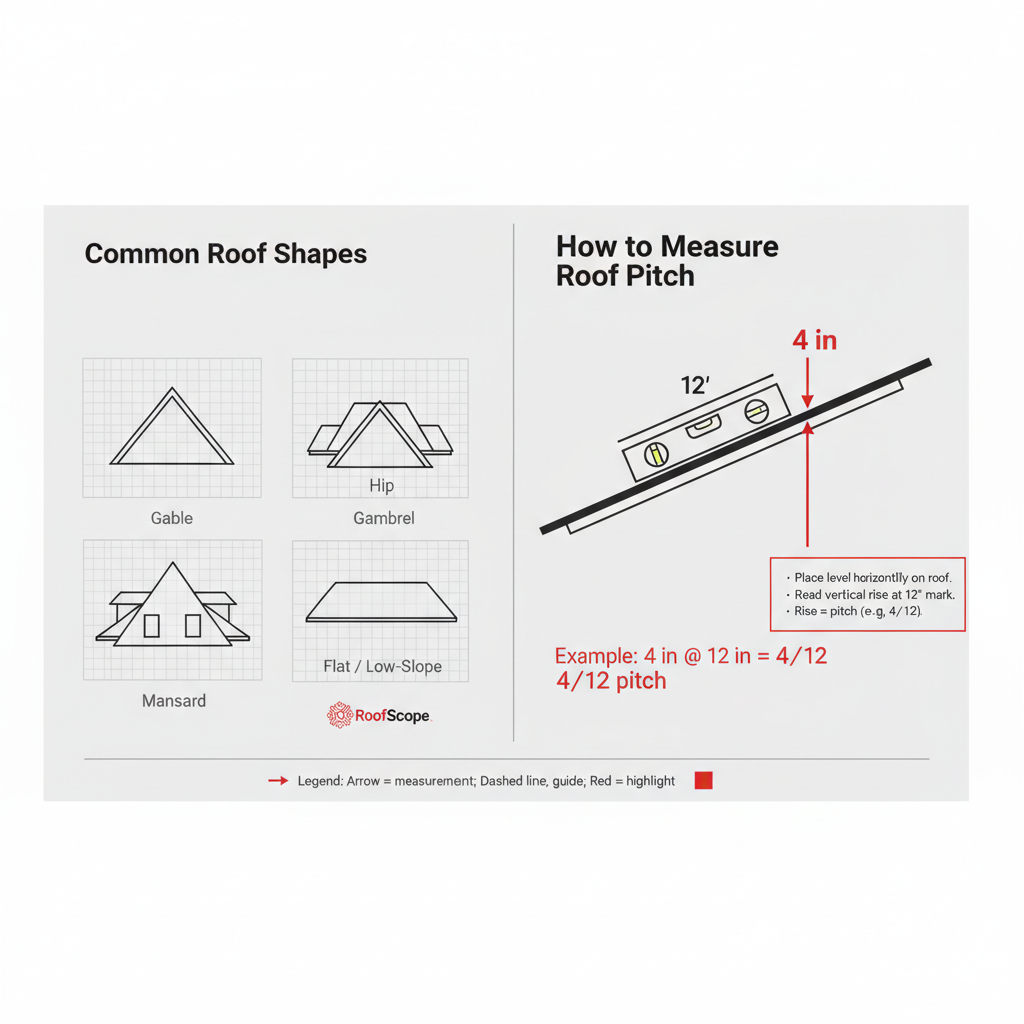Planning a roof replacement, repair, or solar install? The key number is your roof’s total square footage. Because of pitch, overhangs, and complex shapes, the roof area is usually larger than your home’s footprint. Use this step-by-step guide—or skip the math and get RoofScopeX for $15 to see your roof’s total square footage quickly.
Order RoofScopeX — Only $15Example: 40×30 ft home = 1,200 sq ft footprint. With a 4/12 pitch (×1.054), the roof is ≈ 1,265 sq ft.
At a Glance: How Big Is a Roof?
- Not the same as house size: pitch and overhangs add area.
- Quick formula: roof area = footprint × pitch multiplier.
- 1 roofing square = 100 sq ft (e.g., 2,000 sq ft = 20 squares).
- Waste factor: add 10–15% for cuts/complex roofs.
- Find pitch fast: use the Free Roof Pitch Calculator.
- Fastest path: RoofScopeX gives total sq ft + pitch for $15.
What’s Inside
1) Understand Your Roof’s Shape & Pitch
Start by identifying roof type and pitch. Shapes affect how you break the roof into pieces; pitch changes the surface area. Common styles:
- Gable: Two sloped planes meeting at a ridge.
- Hip: Slopes on all four sides; more hips/valleys.
- Mansard/Gambrel: Two slopes per side; larger area.
- Flat/Low-slope: Area closer to footprint.
See examples: 10 different roof types
How to find roof pitch (DIY)
- Place a 12-inch level horizontally on the roof surface.
- At the 12-inch mark, measure straight up to the roof surface.
- The rise in inches is your pitch over 12 (e.g., 4 inches = 4/12).
Prefer a tool? Use the Free Roof Pitch Calculator or the Roof Pitch Tool on the Scope App.

2) Calculate Your Home’s Base (Footprint) Area
Measure the outside length × width of the area under the roof, including eaves/overhangs. For rectangles, multiply once. For L- or T-shapes, split into rectangles and add them up.
Example
40 ft × 30 ft = 1,200 sq ft (footprint)Overhangs: Many homes have ~12–24" eaves. If you measured siding-to-siding, add overhangs or re-measure to the roof edge.
3) Apply a Roof Pitch Multiplier (to get true surface area)
Steeper roofs have more surface area than their footprint. Multiply the footprint by the pitch factor below:
| Pitch (Rise/12) | Multiplier |
|---|---|
| 3/12 | 1.03 |
| 4/12 | 1.054 |
| 5/12 | 1.083 |
| 6/12 | 1.118 |
| 7/12 | 1.158 |
| 8/12 | 1.202 |
| 9/12 | 1.25 |
| 10/12 | 1.302 |
| 12/12 | 1.414 |
Worked Example
1,200 sq ft × 1.054 (4/12 pitch) = 1,264.8 sq ft ≈ 1,265 sq ftSquares Converter (Quick Chart)
Convert roof area to roofing squares (1 square = 100 sq ft):
| Square Footage | Squares |
|---|---|
| 1,200 sq ft | 12 squares |
| 1,600 sq ft | 16 squares |
| 2,000 sq ft | 20 squares |
Need an exact number? Confirm with RoofScopeX ($15).
4) Want Faster & Easier? Two Options
Option A: Use Google Earth/Maps (good for estimates)
- Open Google Earth/Maps and trace your roof outline with the measure tool.
- Note the area, then apply the correct pitch multiplier from the table above.
- Repeat for add-ons (garages, porches) and sum the totals.
Option B: Get a Professional Aerial Measurement (best for accuracy)
RoofScopeX gives you your roof’s total square footage and pitch for just $15, without climbing, drones, or guesswork. Ideal for budgeting, getting quotes, or planning solar.
- Fast turnaround, homeowner-friendly
- Square footage & pitch included
- Simple, pay-as-you-go
Need full measurements and materials? See RoofScope at roofscope.com.
What to Do With the Number You Get
- Roofing estimates: Share square footage & pitch with contractors for accurate bids.
- Material planning: Convert to roofing squares (1 square = 100 sq ft) and add 10–15% waste.
- Solar planning: Use total area and roof planes to assess panel layout.
FAQs: How Big Is a Roof?
Is roof size the same as my home’s square footage?
No. Roofs are larger due to pitch, overhangs, and complex shapes.
What is a “roofing square”?
A roofing square equals 100 square feet of roof area. If your roof is 2,000 sq ft, that’s 20 squares.
How do I find my roof pitch?
Use the Free Roof Pitch Calculator for a quick estimate, or measure with a 12-inch level and tape (rise over 12 inches).
How much waste should I include?
Many projects plan for 10–15% waste; complex roofs with many cuts may need more.
What’s the fastest way to know my roof size?
RoofScopeX — a $15 aerial measurement that reports your roof’s total square footage and pitch. Order now.
Skip the Math — Know Your Roof Size Today
Whether you’re budgeting for shingles, comparing bids, or planning solar, having accurate square footage and pitch saves time and money.
Order RoofScopeX — Only $15Trusted by homeowners and pros. No ladders, no hassle.
written by RoofScope published on 02. 07. 2025

